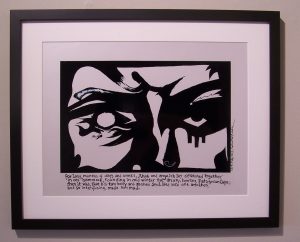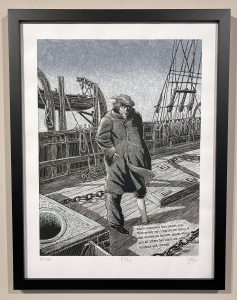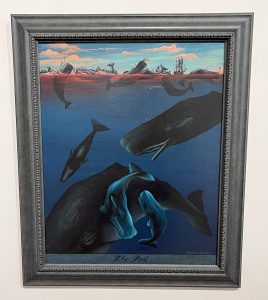International Melville Conference at UConn Avery Point to Celebrate ‘Moby-Dick’ Author
In almost the same way the rope aboard the Pequod “folds the whole boat in its complicated coils,” so too have the details of the 14th International Melville Society Conference around UConn’s Mary K. Bercaw Edwards.
Who knew planning a weeklong event at UConn Avery Point for 150 Herman Melville scholars from lands as far away as those along the route in the hunt for Moby Dick would imitate passages from the English professor’s favorite chapter in the novel by the same name?
The whaling line, Melville writes of the rope, is both “magical, sometimes horrible.”
But once the scholars arrive and the opening plenary address begins on Monday, June 16, Bercaw Edwards says she’ll settle in and enjoy what the week has to offer as the UConn campus and southeastern Connecticut show off their maritime heritage.
“It’s going to be an amazing conference. The talks look outstanding, and everyone is so excited to be in this location,” Bercaw Edwards says.
Titled “Oceanic Melville,” the conference follows a 2022 gathering in Paris and other global destinations through the years including Poland in 2007, Israel in 2009, Italy in 2011, and Japan in 2015. The first was held in Greece in 1997, with gatherings planned generally biennially.

Bercaw Edwards says The Melville Society, an international organization dedicated to the study of the author, asked her to arrange a conference at Avery Point in part because of its proximity to Mystic Seaport Museum just 15 minutes down the road where the Charles W. Morgan, the last wooden whaleship in the world, is on display.
The Morgan was launched in 1841 from New Bedford, Massachusetts, built seven months after and 7 miles away from the Acushnet, the whale ship on which Melville served as a crewmember in the Pacific Ocean before writing “Moby-Dick,” making the Morgan as identical as possible to the Acushnet.
While several days of panel discussions and other academic talks (some are open to the public) on topics ranging from Melville in popular culture to Melville and his animals are the centerpiece of the conference, Bercaw Edwards says a daylong trip to the Museum, where she works in the summer, and the chance to get up close with the Morgan is a highlight.
“They’ll see us raise sails, lower and raise the whale boat. They’ll get to pull on the halyards, which will give them a visceral feeling of what it’s like to set sail,” she says of conference attendees. “We’re also going to give them an opportunity to actually row in whale boats.”
Participants’ day at the Museum also will include the daily activities available to the public, including a concert by staff musicians playing and singing the songs mentioned in “Moby-Dick” and a 35-minute play with three actors using Melville’s words to tell the story of Ahab and the whale.
“Monstrous: Whaling and its Colossal Impact,” the Museum’s newest exhibition that opened in late May and runs through Feb. 16, 2026, by happenstance coincides with the conference.
The exhibition has been built around Mexican American artist Jos Sances’ scratchboard mural, “Or, The Whale,” a 51-foot-long artwork the same size as a juvenile sperm whale. Bercaw Edwards says Sances created the piece after reading and finding inspiration in “Moby-Dick.”
“Sances is a screen printer and a scratchboard artist who’s from Mexico and lives in California – and then he read ‘Moby-Dick’ and was driven to make this mural,” she says. “With his background, there was nothing that would have drawn him naturally to reading a book by a white New England author, but he did just like so many others do.”
‘Deep and Important Questions’
From the perspective of Pequod crewmember Ishmael, “Moby-Dick” tells the story of Captain Ahab’s trek across the globe for vengeance against the albino sperm whale Moby Dick, which took off his leg during a previous encounter.
Some chapters are incredibly dense with precise details about whaling and sailing, while others are so action-packed the story moves quickly. It’s considered among the greatest American novels and for many English majors might be considered their very own white whale.

Bercaw Edwards says she’s oftentimes amazed that today’s audiences are so interested in something written in 1851 – that’s nearly 175 years ago – especially given that it’s authored by a dead, white male and features the killing of whales.
“It seems as politically incorrect as it can possibly be, and yet it feels as if it’s still on the ascendancy,” she says. “It’s a long, dense, tough book, and yet it’s immensely popular. There are graphic novels, movies, plays, concerts, memes, and T-shirts about it.”
She says she once witnessed a colleague who writes about Melville in popular culture mention the word “tattoo” during a talk, and afterward a throng of people gathered around to show him the Melville-inspired artwork on their biceps, forearms, and calves.
“It’s just amazing to me that Melville is so popular. I think it’s because he asks all kinds of deep and important questions: Is there truth? Is there justice? Is there anything beyond our human existence? How do we go about life? And he doesn’t give us any answers. Every time you think ‘OK, that’s the answer,’ he undercuts it. He wants you to realize there are no answers, but he’s asking these great questions. I think that’s part of why it’s still eternal,” she says.
Never mind the beauty of Melville’s writing.
“At the end of Chapter 1, Melville writes, ‘It is but well to be on friendly terms with all the inmates of the place one lodges in.’ I’ve always loved that. We should all get along,” Bercaw Edwards says. “I also love, ‘Ignorance is the parent of fear.’ People are afraid of things they don’t know. It’s so true.”
Pequod third mate Flask fears butter – yes, a stick of butter – Bercaw Edwards continues, noting the humor in the book. He feels as if he’s not entitled to the spread: “So when they’re all eating with Ahab – Starbuck, Stubb, and Flask – they’re always really quiet because they’re kind of nervous around Ahab, and Flask, of course, never dares to take butter. Then Melville writes, ‘For Flask is a butterless man.’”
Reading ‘Moby-Dick’
Every time “Moby-Dick” appears on a syllabus in one of Bercaw Edwards’ classes, she says she gives it a fresh read, no specific routine around it, no tableside requisite cup of black tea to share with Ahab.
She’s delighted in its humor during her at least 35 times rereading it through the years – so many instances that she finds herself quoting it as she goes along. And when she gets to her favorite chapter – number 60, “The Line” – she knows she’ll get the best Melville has to offer.
“He’s describing the whale line, which is attached to the harpoon and thrown into the whale. He has really basic information about the line, about rope, and then it’s infused with all kinds of humor,” she says, quoting his description of hemp: “Hemp is a dusky, dark fellow, a sort of Indian; but Manilla is as a golden-haired Circassian to behold.”
Melville then builds to what Bercaw Edwards calls a “metaphysical lift,” explaining that the whale-line surrounds the boat, crisscrossing it and traveling by each of the crewmembers. He then notes that we’re all surrounded by ropes, and no one knows when it will take you to eternity.
“It’s set up like a sermon,” she says of the chapter. “Sermons pick apart a line from biblical text. This does the same thing. It just does it with real line rather than a line of text.”
Then again, Bercaw Edwards can relate to Melville and journeys around the world better than most.
As her friends shifted into high school upperclassman status at 16 years old, she and her family went to sea, she says. The family of five – Mom and Dad, sister and brother, and her – sailed around the globe on a journey that took 3½ years.
“When I went to college, I knew I wanted to be an English major, but I was thinking I would study Henry James,” she says of the American British author. “Then my professor suggested that with my sailing background I should be a Melville scholar – and now I can’t imagine anything else. All my scholarship has been on Melville, with a little on Joseph Conrad and Jack London, but always centered on Melville.”
She acknowledges, though, that for some, reading “Moby-Dick” might be daunting, to which she offers four words of advice: Visit Mystic Seaport Museum.
Seeing the whale boat demonstrations and getting onboard the Morgan to imagine sleeping in its belly every night for between two and five years oftentimes help people get through those challenging whaling chapters.
She further recommends listening to the story as an audio book.
“When people hear it read aloud, they’ll often see how funny it is. I mean, it’s full of humor, and that’s often lost when people get stuck on the fact that this is The. Great. American. Novel,” she says.
From July 31 to Aug. 1, Mystic Seaport Museum will host its 40th annual “Moby-Dick” Marathon reading of the book to coincide with Melville’s Aug. 1 birthday. Readers gather onboard the Morgan and take about 24 consecutive hours to get through the 135 chapters.
“One of the things I always notice is people listening and then they start to laugh and feel embarrassed, like they’re not supposed to. This is The Great American Novel, but of course we’re supposed to laugh,” she adds.
Public Events and AVS Exhibition
With grant funding from Connecticut Humanities and the Gladys Krieble Delmas Foundation, several events during The Melville Society conference will be open to the public, Bercaw Edwards says.
The opening plenary talk at 10:15 a.m. on Monday, June 16, “Other Seas: Sailing Without Ahab,” will come from St. John’s University English professor Steve Mentz, who’s figured prominently in the field of blue humanities. He will discuss how humans engage with water, along with the history and theory of water-centric thinking.

Then, at 6 p.m. on Wednesday, June 18, “Does the Whale Diminish? – Will He Perish? Cross-Disciplinary Currents in Conversation” will offer a panel discussion with Anne Cohen from the Massachusetts Institute of Technology and Woods Hole Oceanographic Institution, conservation biologist and author Joe Roman, and Portuguese marine researcher Rui Prieto.
The closing plenary address at 4 p.m. on Thursday, June 19, also is open to the public. It features Lenora Warren from Cornell University, one of the leading scholars about Melville and race. Her talk, “Melville’s Ghosts,” dovetails with the day also being Juneteenth.
At the Alexey von Schlippe Gallery of Art at Avery Point, the exhibition “Oceanic Melville” comes together thanks to curator and gallery director Jeanne Ciravolo, along with Bercaw Edwards and Robert K. Wallace from Northern Kentucky University.
Ciravolo says she mentioned during a campus faculty meeting more than a year ago that she enjoys making the gallery’s exhibitions interdisciplinary experiences and afterward Bercaw Edwards asked if she was interested in working together on a show to dovetail with the conference.
“I absolutely was,” Ciravolo says. “I’m a reader. I once thought I’d be an English teacher, but I became an artist, so to have the opportunity to marry literature plus art is very unusual for me and special.”
About two dozen framed artworks on loan from The Melville Society, which houses its collection at the New Bedford Whaling Museum in Massachusetts, are part of the show, along with several artists’ books, Ciravolo says, noting that most of the pieces relate to “Moby-Dick.”
This includes three full-color pieces from artist George Klauba, prints from sculptor and graphic artist Leonard Baskin, and an abstract piece, “Skin’s Path/Moby Dick,” from artist Aileen Callahan, a charcoal on paper that depicts the damaged skin of a whale that’s been beaten with time.
“The idea is to always get a mix of things, a variety of style and media, into the gallery,” Ciravolo says, explaining she and Bercaw Edwards visited the New Bedford Museum to pour through The Melville Society’s full collection, as well as the Museum’s Elizabeth Schultz Collection, and select the most powerful artworks from watercolor to printmaking.
“The scholars who are coming are going to appreciate seeing these artworks,” Ciravolo says. “I love that it will be a generative experience for them and that the public will have the chance to see this very interesting show. We’re here on Long Island Sound, near the whaling center of New England, so it’s a perfect place for this.”
The AVS Gallery is open Thursdays through Sundays from noon to 4 p.m. in the Branford House at UConn Avery Point. It will have extended hours from noon to 4 p.m. on Monday, June 16, and Tuesday, June 17, during the Melville conference for both participants and the public. The “Oceanic Melville” exhibition is open now through Thursday, June 19.
Latest UConn Today
- Labonte named Associate Vice President for University SafetyLabonte's first day as both police chief and AVP will be July 1, 2025
- At UConn’s Queer Science Conference, New Futures Take Shape for Young ScientistsFourth annual event offers high schoolers hands-on fun served up with a scoop of science
- Board of Trustees Member Philip Rubin Continues Legacy of Research, FacilitationTrustee Philip Rubin ’73 ’75 sees UConn and the state as well-positioned to continue groundbreaking research, even in challenging landscape
- Six Recent Graduates Earn Spots in Fulbright U.S. Student ProgramThe program provides grants for individually designed study and research projects or for English teaching assistantships around the world
- Dr. Cato T. Laurencin Represents U.S. at U.S.-Africa Frontiers of Science, Engineering, and Medicine SymposiumUConn's Laurencin represented the U.S. at the third annual U.S.-Africa Frontiers of Science, Engineering, and Medicine Symposium, held in Kigali, Rwanda.
- Partnering to Provide Dental Care to Special Needs PatientsUConn dental residents gain experience practicing at Hospital for Special Care













